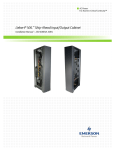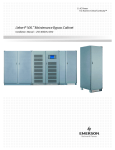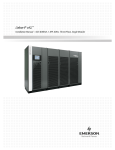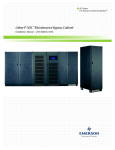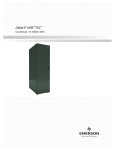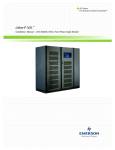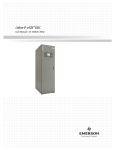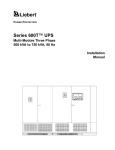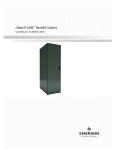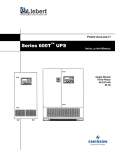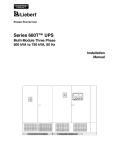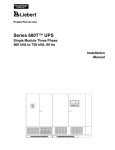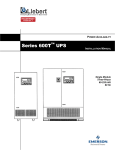Download Emerson NXL 250 Installation manual
Transcript
AC Power For Business-Critical Continuity™ Liebert® NXL™ Ship-Ahead Input/Output Cabinet Installation Manual – 250-400kVA, 60Hz CONTACTING LIEBERT FOR SUPPORT To contact Liebert Services for information or repair service in the United States, call 1-800-LIEBERT (1-800-543-2378). Liebert Services offers a complete range of start-up services, repair services, preventive maintenance plans and service contracts. For repair or maintenance service outside the 48 contiguous United States, contact Liebert Services, if available in your area. For areas not covered by Emerson Network Power Liebert Services, the authorized distributor is responsible for providing qualified, factory-authorized service. For LGS to assist you promptly, please have the following information available: Part numbers: _________________________________________________________________ Serial numbers:________________________________________________________________ Rating: _______________________________________________________________________ Date purchased: _______________________________________________________________ Date installed:_________________________________________________________________ Location: ______________________________________________________________________ Input voltage/frequency: ________________________________________________________ Output voltage/frequency: ______________________________________________________ Battery reserve time:___________________________________________________________ Product Warranty Registration To register for warranty protection, visit the Service and Support section of our Web site at: www.liebert.com Click on Product Registration and fill out the form. TABLE OF CONTENTS 1.0 MECHANICAL INSTALLATION . . . . . . . . . . . . . . . . . . . . . . . . . . . . . . . . . . . . . . . . . . . . . . . .2 1.1 Introduction . . . . . . . . . . . . . . . . . . . . . . . . . . . . . . . . . . . . . . . . . . . . . . . . . . . . . . . . . . . . . . . . 2 1.2 Preliminary Checks . . . . . . . . . . . . . . . . . . . . . . . . . . . . . . . . . . . . . . . . . . . . . . . . . . . . . . . . . . 2 1.3 Environmental Considerations . . . . . . . . . . . . . . . . . . . . . . . . . . . . . . . . . . . . . . . . . . . . . . . . . 2 1.4 Positioning . . . . . . . . . . . . . . . . . . . . . . . . . . . . . . . . . . . . . . . . . . . . . . . . . . . . . . . . . . . . . . . . . 2 2.0 ELECTRICAL INSTALLATION. . . . . . . . . . . . . . . . . . . . . . . . . . . . . . . . . . . . . . . . . . . . . . . . .4 2.1 External Protective Devices. . . . . . . . . . . . . . . . . . . . . . . . . . . . . . . . . . . . . . . . . . . . . . . . . . . . 4 2.2 Power Cables . . . . . . . . . . . . . . . . . . . . . . . . . . . . . . . . . . . . . . . . . . . . . . . . . . . . . . . . . . . . . . . 4 2.3 Configuring Neutral and Ground Connections. . . . . . . . . . . . . . . . . . . . . . . . . . . . . . . . . . . . . 6 3.0 INSTALLATION DRAWINGS . . . . . . . . . . . . . . . . . . . . . . . . . . . . . . . . . . . . . . . . . . . . . . . . . .9 FIGURES Figure 1 Figure 2 Figure 3 Figure 4 Figure 5 Input/output conduit detail drawing, 250-300kVA Liebert NXL UPS . . . . . . . . . . . . . . . . . . . . . . 9 Input/output conduit detail drawing, 400kVA Liebert NXL UPS . . . . . . . . . . . . . . . . . . . . . . . . . 10 Top cable entry routing and installation order . . . . . . . . . . . . . . . . . . . . . . . . . . . . . . . . . . . . . . . . 11 Bottom cable entry routing and installation order . . . . . . . . . . . . . . . . . . . . . . . . . . . . . . . . . . . . . 12 Floor mount brackets—standard and optional layout . . . . . . . . . . . . . . . . . . . . . . . . . . . . . . . . . . 13 TABLES Table 1 Table 2 Table 3 Table 4 Table 5 Table 6 Table 7 Current ratings—rectifier input . . . . . . . . . . . . . . . . . . . . . . . . . . . . . . . . . . . . . . . . . . . . . . . . . . . . Current ratings—bypass input . . . . . . . . . . . . . . . . . . . . . . . . . . . . . . . . . . . . . . . . . . . . . . . . . . . . . Current ratings—output. . . . . . . . . . . . . . . . . . . . . . . . . . . . . . . . . . . . . . . . . . . . . . . . . . . . . . . . . . . Current ratings—battery . . . . . . . . . . . . . . . . . . . . . . . . . . . . . . . . . . . . . . . . . . . . . . . . . . . . . . . . . . Recommended conduit and cable sizes . . . . . . . . . . . . . . . . . . . . . . . . . . . . . . . . . . . . . . . . . . . . . . . Recommended lug sizes . . . . . . . . . . . . . . . . . . . . . . . . . . . . . . . . . . . . . . . . . . . . . . . . . . . . . . . . . . . Lug torque values . . . . . . . . . . . . . . . . . . . . . . . . . . . . . . . . . . . . . . . . . . . . . . . . . . . . . . . . . . . . . . . . i 6 6 6 7 7 8 8 ii IMPORTANT SAFETY INSTRUCTIONS SAVE THESE INSTRUCTIONS This manual contains important instructions that should be followed during installation of your Liebert NXL™ Input/Output Cabinet. Read this manual thoroughly, paying special attention to the sections that apply to your installation, before working with the UPS. Retain this manual for use by installing personnel. ! WARNING Risk of electrical shock. Can cause personal injury or death. Check for voltage with both AC and DC voltmeters before working within the cabinet. Check for voltage with both AC and DC voltmeters before making contact. Only properly trained and qualified personnel wearing appropriate safety headgear, gloves, shoes and glasses should be involved in installing the UPS or preparing the UPS for installation. When performing maintenance with any part of the equipment under power, service personnel and test equipment should be standing on rubber mats. In case of fire involving electrical equipment, use only carbon dioxide fire extinguishers or those approved for use in fighting electrical fires. Extreme caution is required when performing installation. Special safety precautions are required for procedures involving handling, installation of the UPS system. Observe all safety precautions in this manual before handling or installing the cabinet. Observe all precautions in the Operation and Maintenance Manual, SL-25425, before as well as during performance of all maintenance procedures. Observe all DC safety precautions before working on or near the DC system. ! WARNING Risk of heavy unit falling over. Improper handling can cause equipment damage, injury or death. Exercise extreme care when handling the cabinet to avoid equipment damage or injury to personnel. Locate center of gravity symbols and determine unit weight before handling each cabinet. Test lift and balance the cabinets before transporting. Maintain minimum tilt from vertical at all times. Slots at the base of the modules cabinets are intended for forklift use. Base slots will support the unit only if the forks are completely beneath the unit. Read all of the following instructions before attempting to move, lift, remove packaging from or preparing unit for installation. ! WARNING Risk of electrical shock and fire. Can cause equipment damage, personal injury or death. The area around the cabinet should be kept free of puddles of water, excess moisture and debris. Only test equipment designed for troubleshooting should be used. This is particularly true for oscilloscopes. Always check with an AC and DC voltmeter to ensure safety before making contact or using tools. Even when the power is turned Off, dangerously high potential electric charges may exist at the DC connections. All wiring must be installed by a properly trained and qualified electrician. All power and control wiring must comply with all applicable national, state and local codes. One person should never work alone, even if all power is disconnected from the equipment. A second person should be standing by to assist and to summon help in case of an accident. 1 Mechanical Installation 1.0 MECHANICAL INSTALLATION 1.1 Introduction This following section describes the requirements that must be taken into account when planning the positioning and cabling of the Liebert NXL Input/Output Cabinet. This chapter is a guide to general procedures and practices that should be observed by the installing personnel. The particular conditions of each site will determine the applicability of such procedures. NOTICE All equipment not referred to in this manual is shipped with details of its own mechanical and electrical installation. NOTICE Three-phase input supply required. The standard Liebert NXL UPS is suitable for connection to three-phase, four-wire (+ Earth) TN-C, TN-S, IT-G, IT-IG or, three-phase, three-wire plus ground, IT-UG. If using with IT Power system, a 4-pole disconnect device must be included as part of building installation. 1.2 Preliminary Checks Before installing the cabinet, please carry out the following preliminary checks: • Visually examine the cabinet for transit damage, both internally and externally. Report any damage to the shipper immediately. • Verify that the correct equipment is being installed. • Verify that the UPS room satisfies the environmental conditions stipulated in the equipment specification, paying particular attention to the ambient temperature and air exchange system. 1.3 Environmental Considerations 1.3.1 UPS Room The cabinet intended for indoor installation and should be located in a cool, dry, clean-air environment. When bottom entry is used, the conduit plate must be installed. NOTE The UPS is suitable for mounting on concrete or other non-combustible surface only. 1.4 Positioning The Liebert NXL Input/Output Cabinet is structurally designed to withstand lifting from the base. ! CAUTION Risk of unit tipping over. Can cause equipment damage and personal injury. Floor mount brackets must remain attached to the frame until the unit is being placed in its final, installed position. (The final installation will always require the unit to be bolted to another Liebert NXL product.) Failure to comply with these instructions could result in equipment damage and/or injury to personnel. NOTE The UPS must be placed a solid floor. There must be no openings in floor except those required for conduit landing areas. All provided floor skirts must be installed. 2 Mechanical Installation 1.4.1 Moving the Cabinets The Liebert NXL Input/Output Cabinet can be handled with a forklift or similar equipment. When moving the unit by forklift, care must be taken to protect the panels. Do not exceed a 15-degree tilt with the forklift. Bottom structure will support the unit only if the forks are completely beneath the unit. Handling the cabinet with straps is not authorized. 1.4.2 Clearances Clearance around the front of the equipment should be sufficient to enable free passage of personnel with the doors fully open. Installation must leave a distance of 24" (610mm) between the top of the cabinet and any overhead obstacles to permit adequate circulation of air coming out of the unit. Space must be reserved on the left side of the I/O cabinet. The UPS Rectifier/Inverter cabinet can be mounted only on the left side of the I/O cabinet. 1.4.3 Floor Installation/Anchoring If the equipment is to be located on a raised floor, it should be mounted on a pedestal designed to accept the equipment point loading. Refer to the base view to design this pedestal. 3 Electrical Installation 2.0 ELECTRICAL INSTALLATION This chapter provides guidelines for qualified installers who must have knowledge of local wiring practices pertaining to the equipment to be installed. ! WARNING Risk of electrical shock. Can cause injury or death. Check for voltage with both AC and DC voltmeters before working within the cabinet. Only properly trained and qualified personnel wearing appropriate safety headgear, gloves, shoes and glasses should be involved in installing the cabinet or preparing the cabinet for installation. 2.1 External Protective Devices For safety, circuit breakers must be installed in the input AC supply and external battery system. Given that every installation has its own characteristics, this section provides guidelines for qualified installation personnel with knowledge of operating practices, regulatory standards and the equipment to be installed. External overcurrent protection must be provided. See Tables 1 through 4 for overload capacity. Dual Input When wiring the cabinet with a separate rectifier and bypass input, each input must be protected separately. Size the breakers according to the input currents shown in Tables 1 and 2. 2.2 Power Cables The UPS will require both power and control cabling. All control cables, whether shielded or not, should be run separate from the power cables in metal conduits or metal ducts which are electrically bonded to the metalwork of the cabinets to which they are connected The cable design must comply with the voltages and currents in Tables 1 through 4, follow local wiring practices and take into consideration the environmental conditions (temperature and physical support equipment and methods), room temperature and conditions of installation of the cable and system’s overload capacity. For cable entry terminal, refer to Figure 1. ! WARNING Risk of electrical shock. Can cause injury or death. Before cabling the UPS, ensure that you are aware of the location and operation of the external isolators that connect the input/bypass supply to the power distribution panel. Check that these supplies are electrically isolated, and post any necessary warning signs to prevent their inadvertent operation. NOTICE For dual input operation, ensure that any busbars between the bypass and the rectifier input are removed. When sizing battery cables, a maximum volt drop of 2VDC is permissible at the current ratings given in Table 4. 4 Electrical Installation The following are guidelines only and are superseded by local regulations and codes of practice where applicable: • Take special care when determining the size of the neutral cable (grounded conductor), because current circulating on the neutral cable may be greater than nominal current in the case of nonlinear loads. Refer to the values in Tables 2 and 3. • The grounding conductor should be sized according to the fault rating, cable lengths, type of protection, etc. The grounding cable connecting the UPS to the main ground system must follow the most direct route possible. • Consideration should be given to the use of smaller, paralleled cables for heavy currents, as this can ease installation considerably. 2.2.1 Power Cable Connection Procedure Equipment Ground The equipment ground busbar is located as shown in Figure 1. The grounding conductor must be connected to the ground busbar and bonded to each cabinet in the system. All cabinets and cabling should be grounded in accordance with local regulations. NOTICE Proper grounding reduces problems in systems caused by electromagnetic interference. ! WARNING Risk of fire and electrical shock. Can cause equipment damage, personal injury or death. Failure to follow adequate grounding procedures can result in electric shock hazard to personnel, or the risk of fire, should a ground fault occur. All operations described in this section must be performed by properly trained and qualified electricians or technical personnel. If any difficulties are encountered, contact Liebert Services. See the back page of this manual for contact information. The grounding and neutral bonding arrangement must be in accordance with local and national codes of practice. Once the equipment has been positioned and secured, connect the power cables as described in the following procedure. Refer to the appropriate cable connection drawing in Figure 3 or 4. 1. Verify that the equipment is isolated from its external power source. Check that these supplies are electrically isolated and post any necessary warning signs to prevent their inadvertent operation. 2. Open exterior and interior panels on the front of the I/O. 3. Connect the ground and any necessary main bonding jumper to the equipment ground busbar located in the I/O section. a. If the UPS is used in a four-wire system, the neutral ground jumper must be removed. b. The I/O is shipped as a single-input configuration. If the bypass and rectifier input are supplied by different sources, remove the linking bars between the bypass and rectifier terminal. 4. Make power connections and tighten the connections to the proper torque according to one of the two procedures below, depending on the type of installation: NOTE Ensure correct phase rotation. • Top Cable Entry (see Figure 3) • Bottom Cable Entry (see Figure 4) 5 Electrical Installation Top Cable Entry When making the power connections, the recommended order of pulling and installing cables is to start from the top connections to the bottom connections. The cables must be routed around the fault braces (see Detail in Figure 3). This is to prevent the cables from contacting other busbars. The recommended conduit layout is shown in Figure 1. Bottom Cable Entry When making the power connections, the recommended order of pulling and installing cables is to start from the bottom connections to the top connections. The cables must be routed around the fault braces (see Detail in Figure 3. This is to prevent the cables from contacting other busbars. The recommended conduit layout is shown in Figure 1. NOTE For a dual-input configuration, linking busbars between the bypass and the rectifier input must be removed. ! WARNING Risk of electrical shock. Can cause injury or death. If the load equipment will not be ready to accept power on the arrival of the commissioning engineer, ensure that the system output cables are safely isolated at their termination. ! WARNING Risk of electrical shock. Can cause injury or death. When connecting the cables between the battery extremities to the circuit breaker always connect the circuit breaker end of the cable first. NOTE If fault bracing brackets were removed during installation, they MUST be replaced. 5. Close and secure the interior and exterior doors. 2.3 Configuring Neutral and Ground Connections Table 1 Current ratings—rectifier input UPS Rating Voltage, VAC kVA kW Input Bypass Output Nominal Current Maximum Current External 100% Breaker Trip, Amps External 80% Breaker Trip, Amps 250 225 480 480 480 311 389 400 500 300 270 480 480 480 373 466 500 600 400 360 480 480 480 495 618 700 800 Table 2 Current ratings—bypass input UPS Rating Voltage, VAC kVA kW Input Bypass Output Nominal Current 10 Minute Overload External Breaker Trip, Amps 250 225 480 480 480 301 376 400 300 270 480 480 480 361 451 500 400 360 480 480 480 481 601 700 Table 3 Current ratings—output UPS Rating Voltage, VAC kVA kW Input Bypass Output Nominal Current 10 Minute Overload External Breaker Trip, Amps 250 225 480 480 480 301 376 400 300 270 480 480 480 361 451 500 400 360 480 480 480 481 601 700 6 Electrical Installation Table 4 Current ratings—battery UPS Rating kVA kW Nominal VDC 250 300 400 225 270 360 480 480 480 Maximum Battery External Breaker Current at EOD Trip, Amps 618 730 980 700 800 1000 Notes on Tables 1. Nominal input current (considered continuous) is based on full-rated output load. Maximum current includes nominal input current and maximum battery recharge current (considered noncontinuous). Continuous and noncontinuous current are defined in NEC 100. Maximum input current is controlled by the current limit setting which is adjustable. Values shown are for maximum setting of 125%. Standard factory setting is 125%. 2. Recommended bypass external overcurrent protection is based on 125% overload capacity for 10 minutes. 3. All recommended external overcurrent protections are based on 80% rated breakers. 4. Nominal battery voltage is shown at 2.0 volts / cell. Table 5 Recommended conduit and cable sizes Rectifier Input UPS Rating kVA kW Voltage (VAC) Input Bypass Output Nominal Selection (#) Conduit Size, Ph, G Alternate Selection (#) Conduit Size, Ph, G 250 225 480 480 480 (2) 2.5C 3-250kcmil, #1/0AWG (3) 2C 3-#2/0AWG, #1/0AWG 300 270 480 480 480 (2) 3C 3-350kcmil, #1/0AWG (3) 2.5C 3-#4/0AWG, #1/0AWG 400 360 480 480 480 (2) 3.5C 3-500kcmil, #1/0AWG (3) 2.5C 3-250kcmil, #1/0AWG Nominal Selection (#) Conduit Size, Ph, N, G Alternate Selection (#) Conduit Size, Ph, N, G Bypass Input UPS Rating kVA kW Voltage (VAC) Input Bypass Output 250 225 480 480 480 (2) 3C 3-250kcmil; 2-250kcmil, #1/0AWG (3) 2.5C 3-#2/0AWG; 2-#2/0AWG, #1/0AWG 300 270 480 480 480 (2) 3.5C 3-350kcmil; 2-350kcmil, #1/0AWG (3) 3C 3-#4/0AWG; 2-#4/0AWG, #1/0AWG 400 360 480 480 480 (2) 4C 3-500kcmil; 2-500kcmil, #1/0AWG (3) 3C 3-250kcmil; 2-250kcmil, #1/0AWG Nominal Selection (#) Conduit Size, Ph, N, G Alternate Selection (#) Conduit Size, Ph, N, G Output UPS Rating Voltage (VAC) kVA kW Input Bypass Output 250 225 480 480 480 (2) 3C 3-250kcmil; 2-250kcmil, #1/0AWG (3) 2.5C 3-#2/0AWG; 2-#2/0AWG, #1/0AWG 300 270 480 480 480 (2) 3.5C 3-350kcmil; 2-350kcmil, #1/0AWG (3) 3C 3-#4/0AWG; 2-#4/0AWG, #1/0AWG 400 360 480 480 480 (2) 4C 3-500kcmil; 2-500kcmil, #1/0AWG (3) 3C 3-250kcmil; 2-250kcmil, #1/0AWG Nominal Selection (#) Conduit Size, Ph, G Alternate Selection (#) Conduit Size, Ph, G Battery UPS Rating kVA kW Voltage (VAC) Input Bypass Output 250 225 480 480 480 (2) 2.5C 2-350kcmil, #1/0AWG (3) 2C 2-#4/0AWG, #1/0AWG 300 270 480 480 480 (2) 3C 2-500kcmil, #1/0AWG (3) 2C 2-250kcmil, #1/0AWG 400 360 480 480 480 (3) 2.5C 2-500kcmil, #2/0AWG (4) 2.5C 2-250kcmil, #2/0AWG Bonding UPS Rating Voltage (VAC) Input Bypass Output Main Bonding Jumper/Grounding Electrode Conductor kVA kW 250 225 480 480 480 (1) #1/0AWG/ (1) #1/0AWG 300 270 480 480 480 (1) #2/0AWG/ (1) #2/0AWG 400 360 480 480 480 (1) #2/0AWG/ (1) #2/0AWG 1. Recommended cable sizes are 75°C (THW) wire at 30°C ambient. 2. For continous operation not at 30°C, the site planner should choose the appropriate cable type based on the site’s requirements. 7 Electrical Installation Table 6 Recommended lug sizes Cable Size T&B Series 54000 One Hole T&B Series 54000 Two Hole #8 AWG 54930BE 54850BE #6 AWG 54905BE 256-30695-868 #4 AWG 54906BE 256-30695-733 #2-3 AWG 54942BE 54811BE #1 AWG 54947BE 54857BE #1/0 AWG 54950BE 256-30695-593 #2/0 AWG 54951BE 54862BE #3/0 AWG 54965BE 54864BE #4/0 AWG 54970BE 54866BE 250kcmil 54913BE 54868BE 300kcmil 54914BE 54870BE 350kcmil 54915BE 54872BE 400kcmil 54916BE 54874BE 500kcmil 54918BE 54876BE 600kcmil 54920BE 54878BE 750kcmil 54922BE 54880BE Use the T&B crimping tools recommended for these types of lugs. Table 7 Lug torque values Grade 5 Steel - Unified Thread System Torque Units, lbf.*in. Fastener Finish Þ Size 1/4 5/16 3/8 7/16 1/2 9/16 Threads/ Inch, Tpi Plain Steel Zinc Plating Class 8.8 Steel - Metric Thread System Torque Units, N*m Fastener Finish Þ No Washer/ Lock No Washer/ Lock Flat Washer Washer Flat Washer Washer 20 101 — 91 - 28 116 — 104 - 18 209 224 188 203 24 231 246 208 223 16 370 392 333 355 24 420 442 378 400 14 593 — 534 — 20 662 — 596 — 13 904 934 814 844 20 1,020 1,050 918 948 12 1,305 — 1,175 — 18 1,456 — 1,310 — Size M5 M6 M8 M10 M12 M14 8 Thread Pitch, Tp Zinc Plating Plain Steel No Washer/ Lock No Washer/ Lock Flat Washer Washer Flat Washer Washer 0.8 6.1 — 5.5 — 0.5 6.9 — 6.2 — 1 10 — 9 — 0.75 11 — 10 — 1.25 25 — 23 — 1 27 — 24 — 1.5 50 64 45 59 1.25 53 67 47 61 1.75 87 128 78 119 1.25 95 136 86 127 2 139 — 125 — 1.5 151 — 136 — Installation Drawings 3.0 INSTALLATION DRAWINGS Figure 1 Input/output conduit detail drawing, 250-300kVA Liebert NXL UPS DC (2) 3" CONDUIT BYPASS (2) 3.5" CONDUIT INPUT (2) 3" CONDUIT OUTPUT (2) 3.5" CONDUIT LOW VOLTAGE 1.5" CONDUIT TOP VIEW LOW VOLTAGE (14) 1" CONDUIT OUTPUT (2) 3.5" CONDUIT INPUT (2) 3" CONDUIT BYPASS (2) 3.5" CONDUIT DC (2) 3" CONDUIT LOW VOLTAGE 1.5" CONDUIT BOTTOM VIEW SHOWN IN EXTENDED POSITION 76.8 ( 1950 ) BYPASS NEUTRAL DC POSITIVE GROUND BUS (TOP ENTRY) DC NEGATIVE 59.4 (1509) 56.4 (1432) 52.9 (1343) 49.4 46.4 (1255) (1178) 43.4 40.4 ( 1102) (1026) 37.4 34.4 ( 950) (874) 31.4 28.4 ( 797) (721) 25.4 ( 645) 21.9 (556) B SEE NOTE 6 BYPASS INPUT D RECTIFIER INPUT OUTPUT INNER PANEL REMOVED FOR CLARITY A GROUND BUS (BOTTOM ENTRY) C OUTPUT NEUTRAL RIGHT SIDE VIEW FRONT O ( .56 14 ) TYP 1.75 ( 44 ) TYP .87 ( 22 ) .87 ( 22 ) .98 ( 25 ) 1.75 (BOTTOM ( 44 ) TYP ENTRY) 1.75 ( 44 ) TYP 1.75 ( 44 ) TYP (TOP ENTRY) 1.10 ( 28 ) .0 (0) O ( .56 14 ) TYP DETAIL A 1.75 ( 44 ) TYP DETAIL C .56 O ( 14 ) TYP DETAIL B NOTES: 1.75 1. ALL DIMENSIONS ARE IN inches (mm). ( 44 ) 2. 24" MINIMUM CLEARANCE ABOVE UNIT REQUIRED FOR AIR EXHAUST. TYP 3. KEEP CABINET WITHIN 15 DEGREES OF VERTICAL. (BOTTOM 4. TOP AND BOTTOM CABLE ENTRY AVAILABLE THROUGH REMOVABLE ACCESS ENTRY) PLATES. REMOVE, PUNCH TO SUIT CONDUIT SIZE AND REPLACE. 5. UNIT BOTTOM IS STRUCTURALLY ADEQUATE FOR FORKLIFT HANDLING. .88 X .56 SLOT 6. THESE BRACKETS CAN BE REMOVED DURING INSTALLATION BUT MUST BE 6 PLACES REPLACED AFTER INSTALLATION. EACH BAR 7. CONTROL WIRING AND POWER WIRING MUST BE RUN IN SEPARATE CONDUITS. 8. ALUMINUM AND COPPER-CLAD ALUMINUM CABLES ARE NOT RECOMMENDED. 9. ALL WIRING IS TO BE IN ACCORDANCE WITH NATIONAL AND LOCAL ELECTRICAL CODES. 9 1.75 ( 44 ) TYP (TOP ENTRY) DETAIL D .56 O ( 14 ) TYP Installation Drawings Figure 2 Input/output conduit detail drawing, 400kVA Liebert NXL UPS DC (2) 3" CONDUIT OUTPUT (2) 3.5" CONDUIT BYPASS (2) 3.5" CONDUIT INPUT (2) 3" CONDUIT INPUT (2) 3" CONDUIT BYPASS (2) 3.5" CONDUIT OUTPUT (2) 3.5" CONDUIT DC (2) 3" CONDUIT LOW VOLTAGE 1.5" CONDUIT LOW VOLTAGE (14) 1" CONDUIT BOTTOM VIEW TOP VIEW LOW VOLTAGE 1.5" CONDUIT 76.8 ( 1950) BYPASS NEUTRAL DC POSITIVE DC NEGATIVE GROUND BUS LOCATION (TOP ENTRY) 59.4 ( 1509) B 52.9 (1343) SEE NOTE 6 49.4 46.4 (1255) (1178) 43.4 40.4 (1102) (1026) 37.4 34.4 (950) ( 874) 31.4 28.4 (797) ( 721) 25.4 (645) 21.9 ( 556) BYPASS INPUT RECTIFIER INPUT D OUTPUT INNER PANEL REMOVED FOR CLARITY A GROUND BUS (BOTTOM ENTRY) C OUTPUT NEUTRAL FRONT O .56 (14 ) TYP 1.75 (44 ) TYP 1.75 ( 44 ) (BOTTOM TYP ENTRY) .87 ( 22 ) .98 ( 25 ) .87 (22) (TOP ENTRY) 1.10 ( 28 ) DETAIL B O ( .56 14 ) TYP NOTES: 1. ALL DIMENSIONS ARE IN inches (mm). 2. 24" MINIMUM CLEARANCE ABOVE UNIT REQUIRED FOR AIR EXHAUST. 3. KEEP CABINET WITHIN 15 DEGREES OF VERTICAL. 4. TOP AND BOTTOM CABLE ENTRY AVAILABLE THROUGH REMOVABLE ACCESS PLATES. REMOVE, PUNCH TO SUIT CONDUIT SIZE AND REPLACE. 5. UNIT BOTTOM IS STRUCTURALLY ADEQUATE FOR FORKLIFT HANDLING. 6. THESE BRACKETS CAN BE REMOVED DURING INSTALLATION BUT MUST BE REPLACED AFTER INSTALLATION. 7. CONTROL WIRING AND POWER WIRING MUST BE RUN IN SEPARATE CONDUITS. 8. ALUMINUM AND COPPER-CLAD ALUMINUM CABLES ARE NOT RECOMMENDED. 9. ALL WIRING IS TO BE IN ACCORDANCE WITH NATIONAL AND LOCAL ELECTRICAL CODES. 10 .0 (0) RIGHT SIDE VIEW 1.75 ( 44 ) TYP DETAIL A 56.4 (1432) 1.75 ( 44 ) TYP 1.75 ( 44 ) TYP O ( .56 14 ) TYP DETAIL C 1.75 ( 44 ) TYP (TOP ENTRY) 1.75 ( 44 ) TYP (BOTTOM ENTRY) .88 X .56 SLOT 6 PLACES EACH BAR DETAIL D O ( .56 14 ) TYP Installation Drawings Figure 3 Top cable entry routing and installation order OUTPUT CONDUIT INPUT CONDUIT BYPASS CONDUIT DC CONDUIT DC (POSITIVE) DC (NEGATIVE) DC (POSITIVE) DC (NEGATIVE) GROUND (TOP ENTRY) BYPASS NEUTRAL BYPASS NEUTRAL FAULT BRACE BYPASS INPUT FAULT BRACE RECTIFIER INPUT FAULT BRACE OUTPUT BYPASS INPUT RECTIFIER INPUT OUTPUT BYPASS INPUT (PHASE C) FAULT BRACE BYPASS INPUT RECTIFIER INPUT (PHASE C) FAULT BRACE RECTIFIER INPUT OUTPUT (PHASE C) FAULT BRACE OUTPUT GROUND (BOTTOM ENTRY) OUTPUT NEUTRAL OUTPUT NEUTRAL FRONT VIEW SIDE VIEW Recommended order of installation for cables: 1. DC Power 2. Bypass Neutral 3. Bypass Input Power (Phases A-B-C) 4. Rectifier Input Power (Phases A-B-C) 5. Output Power (Phases A-B-C) 6. Output Neutral 7. Ground The cables must be routed around the fault braces. This is to prevent the cables from coming in contact with other busbars. 11 Installation Drawings Figure 4 Bottom cable entry routing and installation order DC (POSITIVE) DC (NEGATIVE) DC (POSITIVE) GROUND (TOP ENTRY) DC (NEGATIVE) BYPASS NEUTRAL BYPASS NEUTRAL FAULT BRACE BYPASS INPUT FAULT BRACE RECTIFIER INPUT FAULT BRACE OUTPUT FAULT BRACE BYPASS INPUT BYPASS INPUT BYPASS INPUT (PHASE C) FAULT BRACE RECTIFIER INPUT RECTIFIER INPUT RECTIFIER INPUT (PHASE C) FAULT BRACE OUTPUT OUTPUT (PHASE C) OUTPUT GROUND (BOTTOM ENTRY) OUTPUT NEUTRAL OUTPUT NEUTRAL OUTPUT CONDUIT INPUT CONDUIT BYPASS CONDUIT DC CONDUIT FRONT VIEW SIDE VIEW Recommended order of installation for cables: 1.) Output Neutral 2.) Output Power (Phases A-B-C) 3.) Rectifier Input Power (Phases A-B-C) 4.) Bypass Input Power (Phases A-B-C) 5.) Bypass Neutral 6.) DC Power 7.) Ground The cables must be routed around the fault braces. This is to prevent the cables from coming in contact with other busbars. 12 Installation Drawings Figure 5 Floor mount brackets—standard and optional layout 20.7 (525mm) 27.4" (695mm) 27.4" (695mm) BOTTOM VIEW (Standard) 7.7" (197mm) 4.7" (120mm) DETAIL AREA FLOOR MOUNTS 36.8" (935mm) 27.4" (695mm) KEEP BRACKETSATTACHED WARNING BOTTOM VIEW (Optional) NOTES: Brackets MUST remain attached to the frame until the unit is being placed in its final installed position. (The final installation will always require the unit to be bolted to another Liebert NXL product.) Failure to comply with these instructions could result in equipment damage and/or injury to personnel. 1. All dimensions are in inches (mm). 2. 24" minimum clearance above unit required. 3. Keep cabinet within 15 degrees of vertical. 4. Top and bottom cable entry available through removable access plates. Remove, punch to suit conduit size and replace. 5. Unit bottom is structurally adequate for forklift handling. 6. Control wiring and power wiring must be run in separate conduits. 7. Aluminum and copper-clad aluminum cables are not recommended. 8. All wiring is to be in accordance with national and local electrical codes. 9. Optional bottom view can be used to bolt input / output cabinet to floor and allow the UPS to be positioned. This option requires the cabinet to be bolted to the floor. 10. Brackets can be removed after the ups has been bolted to the input / output cabinet. 13 Installation Drawings 14 Ensuring The High Availability Of Mission-Critical Data And Applications. Emerson Network Power, a business of Emerson (NYSE:EMR), is the global leader in enabling Business-Critical Continuity™ from grid to chip for telecommunication networks, data centers, health care and industrial facilities. Emerson Network Power provides innovative solutions and expertise in areas including AC and DC power and precision cooling systems, embedded computing and power, integrated racks and enclosures, power switching and controls, infrastructure management, and connectivity. All solutions are supported globally by local Emerson Network Power service technicians. Liebert AC power, precision cooling and monitoring products and services from Emerson Network Power deliver Efficiency Without Compromise™ by helping customers optimize their data center infrastructure to reduce costs and deliver high availability. Technical Support / Service Web Site www.liebert.com Monitoring [email protected] 800-222-5877 Outside North America: +00800 1155 4499 Single-Phase UPS & Server Cabinets [email protected] 800-222-5877 Outside North America: +00800 1155 4499 Three-Phase UPS & Power Systems 800-543-2378 Outside North America: 614-841-6598 Environmental Systems 800-543-2778 Outside the United States: 614-888-0246 Locations United States 1050 Dearborn Drive P.O. Box 29186 Columbus, OH 43229 Europe Via Leonardo Da Vinci 8 Zona Industriale Tognana 35028 Piove Di Sacco (PD) Italy +39 049 9719 111 Fax: +39 049 5841 257 Asia 29/F, The Orient Square Building F. Ortigas Jr. Road, Ortigas Center Pasig City 1605 Philippines +63 2 687 6615 Fax: +63 2 730 9572 While every precaution has been taken to ensure the accuracy and completeness of this literature, Liebert Corporation assumes no responsibility and disclaims all liability for damages resulting from use of this information or for any errors or omissions. © 2009 Liebert Corporation All rights reserved throughout the world. Specifications subject to change without notice. ® Liebert is a registered trademark of Liebert Corporation. All names referred to are trademarks or registered trademarks of their respective owners. SL-25440_REV1_07-10 Emerson Network Power. The global leader in enabling Business-Critical Continuity™ AC Power Connectivity Embedded Computing Embedded Power DC Power Infrastructure Management & Monitoring Outside Plant Power Switching & Controls Precision Cooling EmersonNetworkPower.com Racks & Integrated Cabinets Services Surge Protection Emerson, Business-Critical Continuity, Emerson Network Power and the Emerson Network Power logo are trademarks of Emerson Electric Co. or one of its affiliated companies. ©2010 Emerson Electric Co.




















